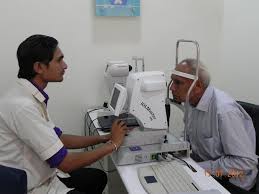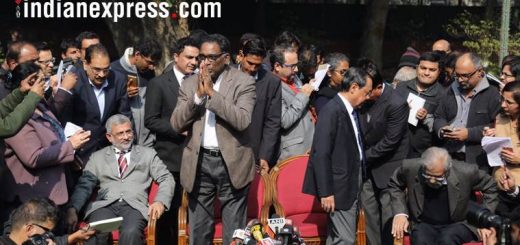‘Modicare’ Unveiled!

While efficacy remains to be judged, Budget has started a much-needed conversation around health.
Rudroneel Ghosh
Times of India
1st February 2018
 (Note: Health care, Obamacare, Modicare! What better publicity stunt can you think of to be in the company of the high and mighty to shine as equal to any among the World Leaders? What remains to be seen is the execution of a plethora of promises he made starting with the promise to put 15 lakh Rupees in every one’s accounts from the money he would be bringing back from funds deposited in foreign banks by tax evaders.
(Note: Health care, Obamacare, Modicare! What better publicity stunt can you think of to be in the company of the high and mighty to shine as equal to any among the World Leaders? What remains to be seen is the execution of a plethora of promises he made starting with the promise to put 15 lakh Rupees in every one’s accounts from the money he would be bringing back from funds deposited in foreign banks by tax evaders.
Another well publicized call was: ‘Sab ka sat,sab ka vikas!” The last 3 years of BJP has proved beyond doubt that if Modi dispensation is fully with the defence and development more of the cow population or with the marginalized dalits and Muslims finding a source of Income in cattle trade.
As for health care, UP shot into prominence where so many children had to breathe their last due to failure on the part of hospitals there to provide oxygen. All the same ‘Modicare’ has kickstarted a national conversation on the importance of the health of every Indian citizen, especially the poor millions who are victims of various diseases and can’t afford the high cost of going to hospitals, which are more interested in fleecing than curing the patients. Health is wealth. What will happen to India, if most of its workforce is sick and bedridden? james kottoor, editor, ccv.
See report below
In a significant Budget announcement, finance minister Arun Jaitley provided for a flagship National Health Protection Scheme under which Rs 5 lakh cover will be provided every year to 10 crore poor and vulnerable families for secondary and tertiary care hospitalisation.
Being dubbed as the world’s largest healthcare scheme or ‘Modicare’, the medical insurance cover is aimed at empowering the poor who suffer the most due to ailments and hospitalisation. Additionally, Rs 1,200 crore has been allotted for 1.5 lakh wellness health centres in the country. Also announced was Rs 600 crore for nutritional support of tuberculosis patients, under which Rs 500 will be provided to each TB patient undergoing treatment. Plus, a total of 24 new government medical colleges have been announced as part of the new initiative for health.
According to some estimates, the premium outgo for the National Health Protection Scheme would be in the range of Rs 2-2.5 lakh crore each year. Hence, this is easily one of the most significant announcements of the Budget. But what’s interesting is that this Budget is the last full Budget that the Modi government is presenting before the next Lok Sabha polls. And such Budgets are usually utilised by the incumbent government to dole out populist schemes and concessions in the hope that these would translate into electoral dividends. In that sense, the Modi government resorting to healthcare as a populist tool to deliver poll results is something new for India.
That said, some questions remain around the National Health Protection Scheme. Budget documents show that the expenditure on health in 2018-19 is pegged at Rs 54,667 crore. So it’s not clear how much of the new scheme will be covered in the next year, given that it will take time to roll out the massive healthcare initiative. Nonetheless, it’s welcome that with this move healthcare has become a national conversation. A major reason why healthcare in this country continues to be in a shambles is that health hitherto was not seen as a political issue. This has resulted in a situation where we have a shortage of doctors, seriously overburdened public hospitals and super expensive private healthcare.
The fallout of this is that doctors today are increasingly seen as carpetbaggers working for corporate interests and prescribing unnecessary treatments at exorbitant rates. All the while the poor of the country continue to suffer diseases for the lack of access to proper medical help. The only way this situation can be turned around is to treat healthcare as a political issue so that every political party is forced to lay out detailed health plans in their election manifestos. Only then will government hospitals, doctors, diagnostic centres and pharmaceutical companies be made more accountable.
While the efficacy and implementation of the National Health Protection Scheme remains to be seen, at least it has started a much-needed political conversation around health that will hopefully divert greater resources and care towards this critical social sector.
(Views expressed above are the author's own).

















Indian Express dated 6th February 2018 states on Modicare:
The lack of details on the massive healthcare insurance scheme shows poor preparedness.Two steps are needed quickly on the health scheme or Modicare as it is being called. First, the government needs to explain how it will work and give full details. Second, it needs to be launched quickly so that the benefits can reach citizens before the government gets into election mode. Otherwise, it may lead to a higher discontent.
Lack of details means higher chances of misinterpretation. The healthcare scheme is an insurance for medical emergencies, specifically hospitalisation. Ten crore families that will be insured will have to pay a nominal amount to be recognised and mapped by the insurance system. Jandhan Aadhaar and Mobile is the digital foundation for rolling out this scheme. The government should not run or manage this scheme that’s in insurance companies’ domain. The government’s job is to usher in reforms by revamping the regulatory structure and digital infrastructure to roll out this scheme.
Changes in regulations will be needed to make sure that the scheme is attractive enough for the sector: insurance companies, healthcare service providers and recipients. The learnings from the failures in the Rashtriya Swasthiya Bima Yojana and the best practices from CGHS, the defence services healthcare schemes, need to be adopted in Modicare. But the scale of the scheme is such that some reforms and incentives may be needed to make sure that private healthcare service providers accept it. It is important that the private sector is part of it as it delivers more than 80 per cent of the healthcare services in the country. They have to accept it; the government cannot expect the poorly-run government hospital sector to deliver the mammoth scheme. Let the mistakes made in NHP 2017 not be repeated with Modicare.
People prefer private hospitals over government ones. If the scheme is structured properly, regulatory reforms done will help in solving the biggest problem ailing the healthcare services. Rising healthcare costs are leading families to bankruptcy and poverty. Government statistics show the number of households facing catastrophic expenditure due to health costs was 18 per cent of all households in 2011-12 compared to 15 per cent in 2004-05. Independent estimates suggest that it would be closer to 30 per cent in 2017-18.
The most important impact of Modicare is that when the government becomes the largest buyer of healthcare services, it can lead to standardisation of medical procedures and prices. This will bring down the overall prices of healthcare services, help improve services and prevent frivolous tests and procedures for even the middle class. To show its sincerity towards this reform, the regulatory structure for healthcare sector should be done before the launch of the scheme.
Any insurance company looking at bidding for this scheme, and I am assuming that the government will not manage it, would be attracted by size. Therefore, the access and delivery through JAM — which means enrolment of citizens already registered as MNREGA beneficiaries or BPL families — will have to be done. This is the digital infrastructure that needs to be leveraged for reaching 10 crore families. Insurance companies would obviously be interested in accessing such large base. The government should, therefore, negotiate the best premium so that the cost to the exchequer and user can be low.
The myth that everything can only be done by allocating large sum of funds has to be broken. Modicare is one reform that can effectively build a new way of delivering better quality of services by creating an enabling environment of regulation and infrastructure around it.
Note:
Rashtriya Swasthya Bima Yojana (RSBY, literally "National Health Insurance Programme", Hindi: राष्ट्रीय स्वास्थ्य बीमा योजना) is a government-run health insurance programme for the Indian poor.The scheme aims to provide health insurance coverage to the unrecognised sector workers belonging to the BPL category and their family members shall be beneficiaries under this scheme. It provides for cashless insurance for hospitalisation in public as well as private hospitals. The scheme started enrolling on April 1, 2008 and has been implemented in 25 states of India. A total of 36 million families have been enrolled as of February 2014. Initially, RSBY was a project under the Ministry of Labour and Employment. Now it has been transferred to Ministry of Health and Family Welfare from April 1, 2015.
Every "below poverty line" (BPL) family holding a yellow ration card pays ₹30 (47¢ US) registration fee to get a biometric-enabled smart card containing their fingerprints and photographs. This enables them to receive inpatient medical care of up to ₹30,000 (US$470) per family per year in any of the empanelled hospitals. Pre-existing illnesses are covered from day one, for head of household, spouse and up to three dependent children or parents.